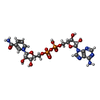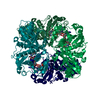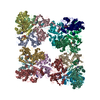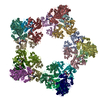+Search query
-Structure paper
| Title | Unravelling the regulation pathway of photosynthetic AB-GAPDH. |
|---|---|
| Journal, issue, pages | Acta Crystallogr D Struct Biol, Vol. 78, Issue Pt 11, Page 1399-1411, Year 2022 |
| Publish date | Nov 1, 2022 |
 Authors Authors | Roberto Marotta / Alessandra Del Giudice / Libero Gurrieri / Silvia Fanti / Paolo Swuec / Luciano Galantini / Giuseppe Falini / Paolo Trost / Simona Fermani / Francesca Sparla /  |
| PubMed Abstract | Oxygenic phototrophs perform carbon fixation through the Calvin-Benson cycle. Different mechanisms adjust the cycle and the light-harvesting reactions to rapid environmental changes. Photosynthetic ...Oxygenic phototrophs perform carbon fixation through the Calvin-Benson cycle. Different mechanisms adjust the cycle and the light-harvesting reactions to rapid environmental changes. Photosynthetic glyceraldehyde 3-phosphate dehydrogenase (GAPDH) is a key enzyme in the cycle. In land plants, different photosynthetic GAPDHs exist: the most abundant isoform is formed by AB heterotetramers and the least abundant by A homotetramers. Regardless of the subunit composition, GAPDH is the major consumer of photosynthetic NADPH and its activity is strictly regulated. While A-GAPDH is regulated by CP12, AB-GAPDH is autonomously regulated through the C-terminal extension (CTE) of its B subunits. Reversible inhibition of AB-GAPDH occurs via the oxidation of a cysteine pair located in the CTE and the substitution of NADP(H) with NAD(H) in the cofactor-binding site. These combined conditions lead to a change in the oligomerization state and enzyme inhibition. SEC-SAXS and single-particle cryo-EM analysis were applied to reveal the structural basis of this regulatory mechanism. Both approaches revealed that spinach (AB)-GAPDH oligomers with n = 1, 2, 4 and 5 co-exist in a dynamic system. B subunits mediate the contacts between adjacent tetramers in AB and AB oligomers. The CTE of each B subunit penetrates into the active site of a B subunit of the adjacent tetramer, which in turn moves its CTE in the opposite direction, effectively preventing the binding of the substrate 1,3-bisphosphoglycerate in the B subunits. The whole mechanism is made possible, and eventually controlled, by pyridine nucleotides. In fact, NAD(H), by removing NADP(H) from A subunits, allows the entrance of the CTE into the active site of the B subunit, hence stabilizing inhibited oligomers. |
 External links External links |  Acta Crystallogr D Struct Biol / Acta Crystallogr D Struct Biol /  PubMed:36322422 PubMed:36322422 |
| Methods | EM (single particle) |
| Resolution | 5.7 - 13.0 Å |
| Structure data | EMDB-13824, PDB-7q53: EMDB-13825, PDB-7q54: EMDB-13826, PDB-7q55: EMDB-13827, PDB-7q56: EMDB-13828, PDB-7q57: |
| Chemicals |  ChemComp-NAD: |
| Source |
|
 Keywords Keywords | OXIDOREDUCTASE / Photosynthesis / Calvin-Benson cycle / redox regulation / glyceraldehyde-3-phosphate dehydrogenase / glyceraldehyde 3-phosphate dehydrogenase |
 Movie
Movie Controller
Controller Structure viewers
Structure viewers About Yorodumi Papers
About Yorodumi Papers













 spinacia oleracea (spinach)
spinacia oleracea (spinach)